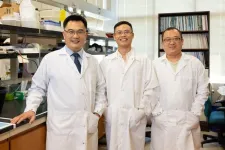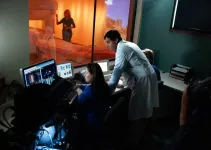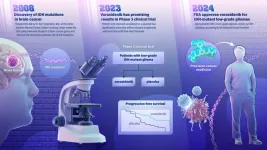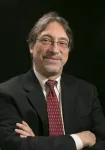(Press-News.org) Los Angeles, California – August 6, 2024 - In a significant leap forward for healthcare equity and accessibility, researchers at the University of Victoria and the Terasaki Institute for Biomedical Innovation (TIBI) have developed a revolutionary system that combines remote health monitoring and drug delivery using 3D-printed hollow microneedles. This innovative approach, detailed in a recent study published in Advanced Healthcare Materials, promises to transform healthcare delivery, particularly for those in underserved or remote regions.
The integrated theranostic microneedle array (MNA) system significantly advances personalized medicine. These 3D-printed hollow microneedles provide painless and minimally invasive access to interstitial fluid, revolutionizing drug delivery and diagnostics.
It features an array of colorimetric sensors that quantitatively measure key health indicators such as pH, glucose, and lactate levels. Simultaneously, the system incorporates a remotely-triggered mechanism for on-demand drug delivery.
One of the most notable features of this technology is its use of an ultrasonic atomizer, which streamlines the drug delivery process. This innovation enables rapid, pumpless, and point-of-care drug administration, significantly enhancing the system's portability and reducing complexity.
The system's capabilities are impressive, with a demonstrated ability to detect pH levels ranging from 3 to 8, glucose concentrations up to 16 mm, and lactate levels up to 1.6 mm. These measurements provide crucial data for monitoring various health conditions.
A vital component of this technology is its accompanying smartphone application, which serves as an interface for both the sensing and drug delivery functions. This user-friendly approach ensures that patients and healthcare providers can easily access and interpret the data and control the drug delivery process.
The implications of this technology are far-reaching. By enabling remote health monitoring and treatment, it has the potential to bridge geographical and socioeconomic disparities in healthcare access. This democratization of healthcare could lead to more timely interventions, continuous monitoring, and truly personalized care, regardless of a patient's location or economic status. The system's potential impact on managing chronic diseases that require long-term treatment is particularly promising. The ability to deliver medications on-demand and monitor health indicators non-invasively could significantly improve patient outcomes and quality of life. As healthcare systems worldwide grapple with issues of equity and access, this technology offers a glimpse into a future where quality healthcare is not limited by geography or socioeconomic factors. This system combines remote monitoring, on-demand drug delivery, and user-friendly interfaces. It represents a significant step towards a more equitable distribution of health resources and outcomes.
Dr. Ali Khademhosseini, CEO of the Terasaki Institute for Biomedical Innovation and a renowned expert in bioengineering, commented, "This innovative approach confronts drug delivery challenges, particularly in managing chronic diseases requiring long-term treatment, while also offering avenues for non-invasive health monitoring through microneedle-based sensors."
The researchers behind this groundbreaking work have addressed current drug delivery and health monitoring challenges and paved the way for future innovations in personalized, accessible healthcare for all.
###
For more information, please contact:
Stewart Han
Email: shan@terasaki.org
Alireza Hassani, Ph.D.
Email: hassania@terasaki.org
Grant Information: This study received backing from the Natural Sciences and Engineering Research Council of Canada (NSERC), the International Collaboration on Repair Discoveries (ICORD), the Canadian Institutes for Health Research (CIHR), and the Canadian Foundation for Innovation (CFI).
About Terasaki Institute for Biomedical Innovation (TIBI):
The Terasaki Institute for Biomedical Innovation is a non-profit research organization dedicated to leveraging cutting-edge technology to address global health challenges. By fostering interdisciplinary collaborations and pushing the boundaries of innovation, TIBI aims to transform healthcare and improve lives worldwide.
END
Cutting-edge 3D-printed microneedle technology revolutionizes remote healthcare
2024-08-07
ELSE PRESS RELEASES FROM THIS DATE:
Blood test can help predict chronic lung disease in preterm babies
2024-08-07
A blood test can help predict which preterm babies will go onto develop chronic lung disease, allowing for earlier diagnosis and more targeted treatments, according to a new study.
The research, led by Murdoch Children’s Research Institute (MCRI) and published in the American Journal of Respiratory Cell and Molecular Biology found that changes in certain blood proteins, alongside gestational age, birth weight and sex, strongly predicated bronchopulmonary dysplasia (BPD) within 72 hours of life.
BPD usually occurs when a baby’s lungs are damaged by respiratory support and the long-term ...
Demystifying APE1: New findings on direct activation of ATM signaling by DNA single-strand breaks
2024-08-07
New research from a team of genome scientists and DNA damage response experts breaks new ground in understanding the function of a protein currently limited in clinical trials for cancer treatments.
Led by Haichao Zhao, PhD, in the Yan Lab at UNC Charlotte, the new research shows how ATM-mediated signaling is induced by DNA single-strand breaks (SSBs) for DNA damage repair – illuminating the distinct mechanisms of SSB-induced ATM kinase and shedding an important light on APE1 function.
In the new study, published today in Nature Communications, ...
Study suggests an MRI may help doctors predict more aggressive prostate cancer in patients
2024-08-07
SOUTHFIELD, MI, Aug. 7, 2024 - New Corewell Health™ research suggests an MRI scan can help predict whether patients with intermediate-risk prostate cancer (cancer confined to the entire prostate) may have more aggressive cancer in five years. Knowing this could potentially help doctors determine if treatment is needed up front vs. using a method called active surveillance where the disease is closely monitored over time. The study, recently published in the Journal of Urology, is the first to evaluate this risk group.
Currently, there has been a growing trend to manage low-risk prostate cancer patients with active ...
FDA approves drug targeting Johns Hopkins-discovered brain cancer gene mutation
2024-08-07
FOR IMMEDIATE RELEASE
A new drug for treatment of a type of brain cancer, called IDH-mutant low-grade glioma, was approved Aug. 6 by the U.S. Food and Drug Administration (FDA). The promising new drug stems from a 2008 genetic discovery made at the Johns Hopkins Kimmel Cancer Center.
The drug, called vorasidenib, is a targeted cancer therapy that works by inhibiting the activity of a mutated gene called IDH, slowing the growth of the cancer. The gene was identified by Bert Vogelstein, M.D., and team at the Johns Hopkins Kimmel Cancer Center’s ...
LOINC® semiannual release: Global partners collaborate to enhance semantic interoperability with health terminology updates
2024-08-07
INDIANAPOLIS -- Regenstrief Institute’s latest LOINC® content update underscores significant strides in health terminology, accomplished through extensive collaboration with the international health community. The semiannual release aims to bolster the electronic exchange of clinical and laboratory data, fostering the use and implementation of LOINC standards across healthcare systems globally.
The Regenstrief Institute Health Data Standards (HDS) unit, which administers LOINC, and partners collaborated to create more than 3,000 updates, including ...
Researchers show pesticide contamination is more than apple skin deep
2024-08-07
Pesticides and herbicides are critical to ensuring food security worldwide, but these substances can present a safety risk to people who unwittingly ingest them. Protecting human health, therefore, demands sensitive analytical methods to identify even trace levels of potentially harmful substances. Now, researchers reporting in ACS’ Nano Letters have developed a high-tech imaging method to detect pesticide contamination at low levels, and its application on fruits reveals that current food safety practices ...
Current challenges evaluated for measuring and treating fatigue in multiple sclerosis
2024-08-07
East Hanover, NJ – August 7, 2024 – Kessler Foundation research scientist John DeLuca, PhD, has published a significant clinical article in Journal of Neurology, shedding light on the elusive nature of fatigue in multiple sclerosis (MS) and its implications for treatment. The study provides a comprehensive review of current challenges in defining, measuring, and treating MS-related fatigue, offering new insights and directions for future research.
The open access article, “Fatigue in multiple sclerosis: can we measure it and can we treat it?” (Doi: 10.1007/s00415-024-12524-9), was published on July ...
Disparities found in survival benefits for people receiving bystander CPR for cardiac arrest
2024-08-07
A National Institutes of Health (NIH)-supported study has found race- and sex-based differences in the increased chances of survival from people who received bystander cardiopulmonary resuscitation (CPR) for out-of-hospital cardiac arrest. Average survival benefits for cardiac arrest, when the heart suddenly stops beating, could be three times as high for white adults compared to Black adults and twice as high for men compared to women. The findings published in Circulation.
“CPR saves lives — that, we know,” said Paula Einhorn, M.D., a program officer at NIH’s National, Heart, Lung, and Blood Institute ...
Florey research finds association between prenatal exposure to plastics and autism in boys
2024-08-07
Florey researchers have found evidence of higher levels of the plastic chemical bisphenol A (BPA) in pregnant mothers who gave birth to sons with autism.
Research published in Nature Communications, led by Florey scientists Dr Wah Chin Boon and Professor Anne-Louise Ponsonby, supports the hypothesis of a possible link between autism and exposure to plastic chemicals in the womb.
Professor Ponsonby said the researchers analysed two large birth cohorts – the Barwon Infant Study (BIS) in Australia and the Columbia Centre for Children’s Health and Environment in the USA.
“Exposure to plastic chemicals ...
World’s highest-performance superconducting wire segment fabricated at UB
2024-08-07
BUFFALO, N.Y. — Our energy future may depend on high-temperature superconducting (HTS) wires. This technology’s ability to carry electricity without resistance at temperatures higher than those required by traditional superconductors could revolutionize the electric grid and even enable commercial nuclear fusion.
Yet these large-scale applications won’t happen until HTS wires can be fabricated at a price-performance metric equal to that of the plain copper wire sold at your ...





